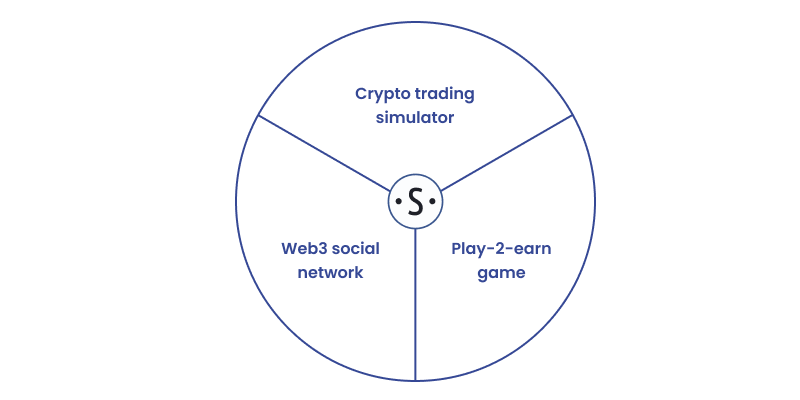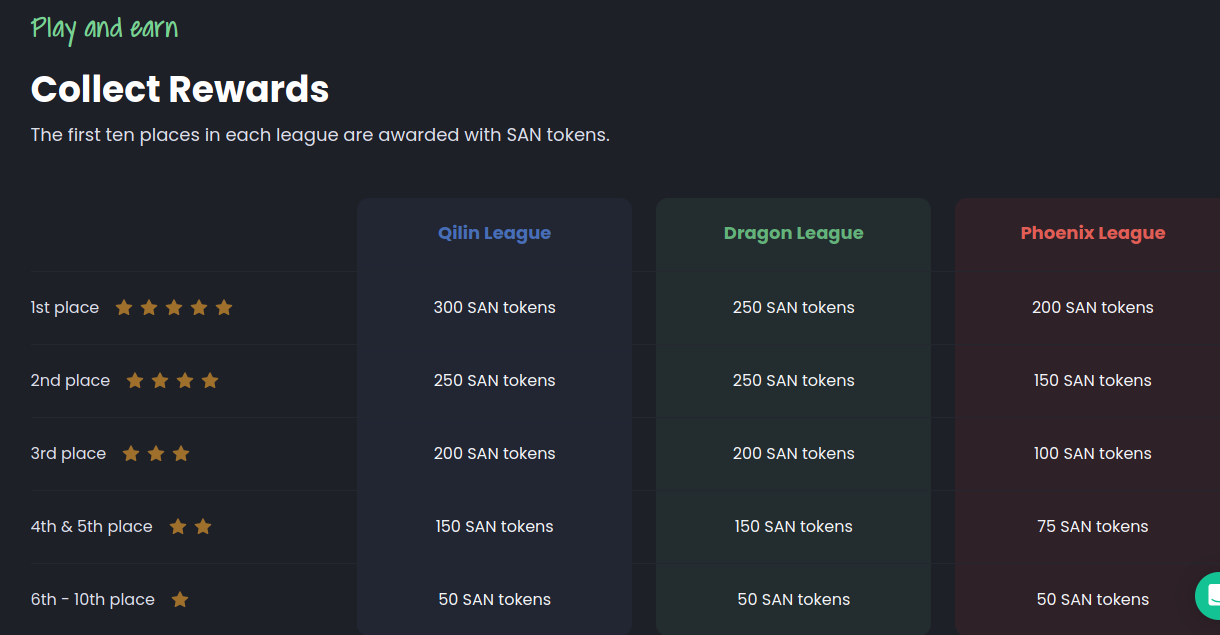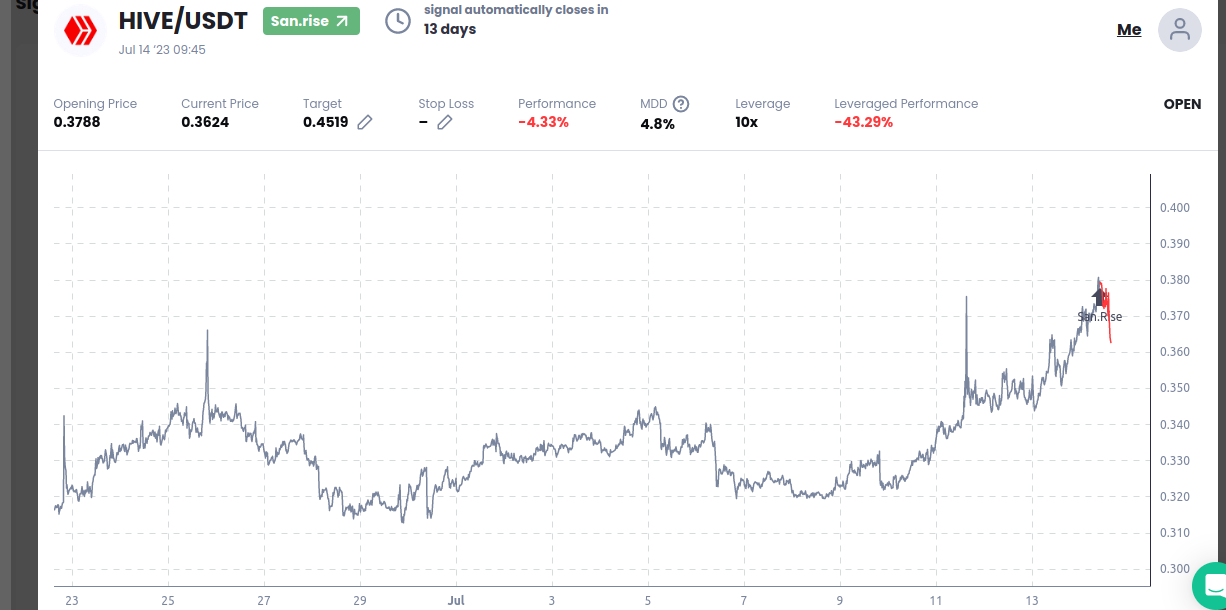ENGLISH VERSION

Leofinance is the largest finance community within Hive, while SanR focuses on helping us to improve the management of our finances in the area of crypto-trading, one of the most exciting, but at the same time the one with the most risk involved, as trading any asset class always has its risks, in the case of cryptocurrencies this is further enhanced due to the high volatility of their price.
This is why we believe that the current partnership between Leofinance and SanR is exceptional, because this is a crypto-trading simulation platform where we do not risk real money (what is traditionally known as paper trading), allowing us to free ourselves from the psychological pressure of taking financial risks while entrenching our practices through the experience that participation in the platform gives us.
In addition to this, we can opt to receive some prizes in the project token ($SAN) according to our performance in the competitions that are constantly held. For a first approach to this platform, it is important to consider the following points:
Behind SanR: Santiment
SanR is part of a larger project, santiment, where we can find several products and services that help us as ideal complementary, complementary and very good tools for trading analysis. Thus, SanR is one of these services and products that are available, which gives us an interesting context of the value it holds.
This seems to me important to note, as it opens the horizon to the diversity of options that we can find here and that can help us in our practices, plus it makes us realize that we really are facing a great partnership, since in leofinance there are several members, some who certainly have extensive experience in trading, but others who do not, because we are just starting, in both cases, SanR along with santiment gives us access to data that help detect changes in the crypto market and the consequent improvement of our analysis and decision making.
How to get start?
From the beginning SanR makes us feel in a web 3 environment, since the way to enter is through a wallet, metamask and WalletConnect at the moment. Then, when we enter the application we have several tabs:
Feed. Here we can see the latest operations, whether opened or closed, likewise there is also a small statistic of the performance obtained in the last 24 hours. This tab is important as a first approach to how the market sentiment of the participants is, in terms of which assets are being traded more and in which direction (long or short).
Leaderboard. Here we find different rankings; firstly, the current competition (each one lasts 14 days as we will see in another tab) with its opening date, closing date and when the rewards will be distributed. In the same way, here we also have how many people are participating (forecasters) and how many signals are open.
Finally, what is our position in the 3 classifications that exist: Phoenix, the worst performers (those in losses); dragon, the best performers (those in gain) and Qilin, the average performance overall, taking into account losses (phoenix) and ganancais (dragon), since we are all evaluated in these three tables.
In this same tab we also get a more detailed information of each leaderboard, a summary of the token staking rewards as well as a summary of the current competition both on the side of the participants and the open signals.
- Signals. This is one of the tabs, from my point of view, more important, since here we have a more specific analysis of each token listed on the platform, what is the sentiment of people regarding them (bullish, SanRises or bearish, SanSets) both at a particular level and at a general level, well, they are grouped into specific sectors according to the main focus of the project: Metaverse, NFT, Blockchain, Exchange, DeFi, Layer2, Meme and Dao.
We also have a graph that describes to which sector the operations are heading more, as well as the possibility of displaying a map of how many specific signals are open for each pair of tokens, which is extremely useful to be more accurate when analyzing the convenience or not to follow a signal.
And, in the end, this tab is useful precisely because it allows us to study behaviors, patterns and / or decisions to the fluctuations of cryptoassets to go forming a trading strategy or improving our own. We especially like that here we can filter both open and closed signals according to the requirements we give to our search.
- Epochs. Here we can see the various competitions, which last the time of a lunar phase, both the new moon and the full moon (14 days respectively), therefore, we have the possibility in one phase to open and close as many operations as we want (although the limit is 10), but in the other, we can only close the ones we have already opened since the previous phase, this because after completing a lunar cycle (a new moon plus a full moon) the rewards are delivered.
For this reason, in this tab we see in addition to the possibility of accessing the results obtained from all the competitions made (all time), three other options: the completed phase (because the rewards have already been delivered), the phase that is ending (because the last operations are being closed) and the current phase (which is where we can open all the operations we want and leave them open to close them in the next phase).
Here we can see the leaderboard of each phase or competition, especially the one that refers to the global of all the competitions (all time), because it gives us the data to study the performance in the operations opened by the participants and even in the performances that in general have had the signals.
- Clubs. This is a super special tab because any crypto community (such as leofinance) can create their own guild and make their own competitions, now running the first one, as was announced a few days ago, with a juicy prize of $300 in $LEO and $SAN tokens.
In addition to this, each community has its own page where there is a community leaderboard, as well as the overall performance of the community.
- User Profiles. Finally, we can enter the icon of our user and find very useful options such as customizing our name, profile picture, etc.. Besides we have a box where there are several tabs that summarize our statistics, which is useful to measure our performance and analyze the way in which we are operating, so decide on its usefulness or need for any change.
The $SAN token can be staked, this is where we find this possibility, in addition to tracking our investment. Another interesting possibility is that we have a tab of the people we follow, in case we want to make a study of their analysis, making a note of it that will only be seen in our profile.
How works?
SanR.app is a platform where we share Crypto-trading analysis signals, this way we practice and improve our skills in the area, also we don't need to risk real money and instead we can choose to earn some rewards as well as organize our own from a specific club. Therefore, the basic and main function that we must handle is to open and/or close signals, since the way to see and analyze the signals that others share was covered with the description of what we can do in each of the tabs.
With respect to this operation what we must keep in mind is:
- Open the form to create signals (which is very clearly available in the navigation bar) - In the form only the first two fields are mandatory. The first one where we choose the token to trade, and the second one where we set whether we believe it will go up (SanRise) or down (SanSet) - The other fields although optional are very useful too, as we can set our stop loss and take profit, use leverage, schedule our entry and give more details about our trade (like a title and description of it) - Finally, to finish creating our signal we have to confirm in our wallet, as it is registered in the project's blockchain. It should be noted that it is not necessary to pay any gas fee for this.
My little experience
I have liked the platform, as it is very simple to use, and little by little more people have been joining who with their operations give me an overview of the market or, rather, complement the one that from my analysis I have done.
So far I have opened 3 trades, of which I have closed 2 successfully. In $FTM I opened on July 10 at 0.2783 with a take profit on July 13 at 0.2891. This was a test only. The second one was preceded with a bit more analysis and so I leveraged x7, it was on $MANA, I opened it yesterday July 13 and closed it this same day, the open was at 0.3954 and the take profit at 0.4169.
Today I found out that $HIVE has been added among the tokens to trade and as we know that it has practically not joined the party of the other altocins, sponsored by $XRP, I have fully leveraged to the maximum (x10), I opened at 0.3788 and I have a maximum take profit at 0.4519, as a short-medium term objective.

VERSIÓN EN ESPAÑOL

Leofinance es la mayor comunidad de finanzas dentro de Hive, mientras SanR se enfoca en ayudarnos a mejorar la administración de nuestras finanzas en el área del crypto-trading, una de los más emocionantes, pero al mismo tiempo la que más riesgo tiene implícito, pues siempre el comercio de cualquier clase de activos tiene sus riesgos, en el caso de las criptomonedas esto se potencia aún más debido a la alta volatilidad de su precio.
Es esta la razón por la cual creemos que la actual asociación entre Leofinance y SanR es excepcional, porque este es una plataforma de simulación de crypto-trading donde no arriesgamos dinero real (lo que tradicionalmente se conoce como paper trading), permitiéndonos liberarnos de la presión psicológica de asumir riesgos financieros mientras afianzamos nuestras prácticas mediante la experiencia que nos da la participación en la plataforma.
Además de esto, podemos optar en recibir algunos premios en el token del proyecto ($SAN) según sea nuestra desempeño en las competiciones que constantemente se realizan. Para un primer acercamiento a esta plataforma, es importante que consideremos los siguientes puntos:
Más allá de SanR: Santiment
SanR forma parte de un proyecto más grande, santiment, donde podemos encontrar varios productos y servicios que nos ayudan como complemento ideales, herramientas complementarias y muy buenas para el análisis del trading. De esta manera, SanR es uno de estos servicios y productos que están a disposición, lo cual nos da un contexto interesante del valor que el mismo encierra.
Esto me parece importante hacer notar, ya que nos abre el horizonte hacia la diversidad de opciones que aquí podemos encontrar y que nos pueden ayudar a nuestras prácticas, además de que nos hace percatarnos de que realmente estamos ante una estupenda asociación, puesto que en leofinance hay diversos integrantes, unos que ciertamente tienen una gran experiencia en el trading, pero otros que no, pues apenas estamos comenzando, en ambos casos, SanR junto con santiment nos brinda acceso a datos que ayudan a detectar los cambios en el mercado crypto y la consiguiente mejora de nuestros análisis y toma de decisiones.
¿Cómo comenzar?
Desde un principio SanR nos hace sentirnos en ambiente de web 3, puesto que la forma de ingresar es a través de una wallet, metamask y WalletConnect por el momento. Luego, al entrar en la aplicación tenemos varias pestañas:
Feed. Aquí podemos ver las últimas operaciones, ya sean abiertas o cerradas, de igual manera también hay una pequeña estadística del rendimiento obtenido las últimas 24 horas. Esta pestaña es importante como un primer acercamiento a cómo está el sentimiento del mercado en los participantes, en cuanto qué activos se están operando más y en qué sentido (largos o cortos).
Leaderboard. Nos encontramos aquí con diferentes rankings; primeramente, la competición actual (cada una dura 14 días como veremos en otra de las pestañas) con su fecha de apertura, la de cierre y cuándo serán repartidas las recompensas. De la misma manera, aquí también tenemos cuántas personas están participando (forecasters) y cuántas señalas hay abiertas.
Finalmente, cuál es nuestra posición en las 3 clasificaciones que existen: Phoenix, los que peor rendimiento han tenido (los que están en pérdidas); dragon, los que mejor rendimiento han tenido (los que están en ganancia) y Qilin, el promedio de rendimiento en general, teniendo en cuenta las pérdidas (phoenix) y las ganancais (dragon), ya que todos somos evaluados en estas tres tablas.
En esta misma pestaña también conseguimos una información más detallada de cada tabla clasificatoria, un resumen de las recompensas por staking del token así como un resumen de la competición actual tanto del lado de los participantes como de las señales abiertas.
- Signals. Es una de las pestañas, desde mi punto de vista, más importante, ya que aquí tenemos un análisis más específico de cada tokens listado en la plataforma, cuál es el sentimiento de las personas respecto a ellos (alcistas, SanRises o bajistas, SanSets) tanto a nivel particular como a nivel general, pues, están agrupados en sectores específicos según sea el foco principal del proyecto: Metaverso, NFT, Blockchain, Exchange, DeFi, Layer2, Meme y Dao.
También tenemos un gráfico que nos describe a cuál sector están dirigiéndose más las operaciones, así como la posibilidad de desplegar un mapa de cuántas señales específicas hay abiertas para cada par de tokens, lo cual resulta sumamente útil para ser más certeros a la hora de analizar la conveniencia o no de seguir una señal.
Y es que, al final, esta pestaña es útil precisamente porque nos permite estudiar comportamientos, patrones y/o decisiones ante las fluctuaciones de los criptoactivos para ir formándonos una estrategia de trading o mejorando la propia. De manera especial nos gusta que aquí podemos filtrar tanto las señalas abiertas como cerrada según los requerimientos que le demos a nuestra búsqueda.
- Epochs. Aquí podemos ver las diversas competiciones, que duran el tiempo de una fase lunar, tanto la de luna nueva como la de luna llena (14 días respectivamente) por eso, tenemos la posibilidad de en una fase abrir y cerrar cuántas operaciones queramos (aunque el límite es de 10), pero en la otra, solo podremos cerrar las que ya llevamos abiertas desde la fase anterior, esto porque luego de completado un ciclo lunar (una luna nueva más una luna llena) se hacen efectivas las entregas de las recompensas.
Por esta razón, en esta pestaña vemos además de la posibilidad de acceder a los resultados obtenidos desde todas las competiciones hechas (all time), otras tres opciones: la fase completada (porque ya se han entregado las recompensas), la fase que está finalizando (porque se están cerrando las últimas operaciones) y la fase actual (que es donde podemos abrir todas las operaciones que queramos y dejarlas abiertas para cerrarla en la próxima fase).
Aquí podemos ver el leaderboard de cada fase o competición, de manera especial nos llama la atención la que se refiere al global de todas las competiciones (all time), pues, nos facilita los datos para estudiar el rendimiento en las operativas abiertas por los participantes e incluso en los rendimientos que en general han tenido las señales.
- Clubs. Es una pestaña superespecial porque cualquier comunidad crypto (como leofinance) puede crear su propia guild y hacer sus propias competiciones, ahora está corriendo la primera, como fue anunciado hace unos días, con una jugosa premiación de 300 $ en tokens de $LEO y $SAN.
Además de esto, cada comunidad tiene su propia página donde existe un leaderboard propio de la misma, así como el rendimiento en general de la comunidad.
- User Profiles. Finalmente, podemos ingresar al ícono de nuestro usuario y encontrarnos con opciones muy útiles así como personalizar nuestro nombre, foto de perfil, etc. Aparte tenemos un recuadro donde hay varias pestañas que resumen nuestras estadísticas, lo cual es útil para medir nuestro rendimiento y analizar la forma en la cual estamos operando, así decidir sobre su utilidad o necesidad de algún cambio.
Al token $SAN le podemos hacer staking, aquí es donde nos encontramos con esta posibilidad, además de hacerle seguimiento a nuestra inversión. Otras de las posibilidades interesantes es que tenemos una pestaña de las personas que seguimos, por si queremos hacer un estudio de sus análisis, haciendo una nota del mismo que solo se verá en nuestro perfil.
¿Cómom funciona?
SanR.app es una plataforma donde compartimos señales de análisis de Crypto-trading, de esta manera practicamos y mejoramos nuestras habilidades en el área, además no necesitamos arriesgar dinero real y, en cambio, podemos optar por ganar algunas recompensas así como organizar las propias desde un club en específico. Por ello, la función básica y principal que debemos manejar es la de abrir y/o cerrar señales, ya que la forma de ver y analizar las señales que otros comparten fue abarcada con la descripción de lo que podemos hacer en cada una de las pestañas.
Al respecto de esta operación lo que debemos tener en cuenta es:
- Abrir el formulario para crear señales (el cual está disponible muy claramente en la barra de navegación).
- En el formulario solo son obligatorios los primeros dos campos. El primero donde elegimos el token a operar, y el segundo donde establecemos si creemos irá hacia arriba (SanRise) o hacia abajo (SanSet).
- Los otros campos aunque opcionales son muy útiles también, ya que podemos establecer nuestros stop loss y take profit, usar apalancamiento, programar nuestra entrada y dar más detalles sobre nuestra operación (como un título y descripción de la misma).
- Finalmente, para terminar de crear nuestra señal tenemos que confirmar en nuestra wallet, ya que la misma queda registrada en la blockchain del proyecto. Cabe señalar que no es necesario pagar ningún fee de gas para ello.
Mi pequeña experiencia
Me ha gustado la plataforma, ya que es muy sencilla de usar, y poco a poco se han ido uniendo más personas que con sus operativas me dan una visión general del mercado o, mejor dicho, complementan la que desde mi análisis he hecho.
Hasta el momento he abierto 3 operaciones, de las cuáles he cerrado 2 de manera exitosa. En $FTM abrí el 10 de julio a 0.2783 con un take profit el 13 de julio a 0.2891. Esta fue una prueba solamente. La segunda fue precedida con un poco más de análisis y, por eso, me apalanqué x7, fue en $MANA, la abrí ayer 13 de julio y la cerré este mismo día, la apertura fue en 0.3954 y el take profit en 0.4169.
Hoy me ocnseguí con que ya añadieron a $HIVE entre los tokens para operar y como sabemos que prácticamente éste no se ha unido a la fiesta de las demás altocins, auspiciada por $XRP, me he apalancado totalmente al máximo (x10), abrí en 0.3788 y tengo un take profit máximo en 0.4519, como objetvio a corto-mediano plazo.
NOTE The post images are screenshot taken from SanR.app







